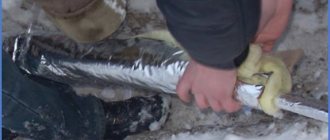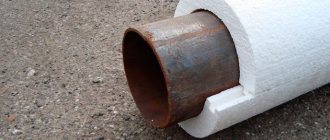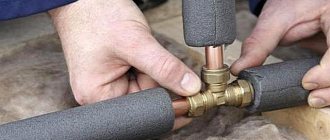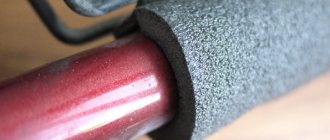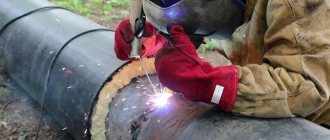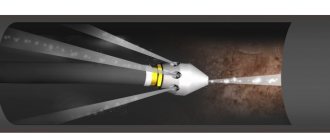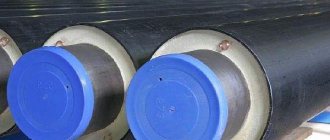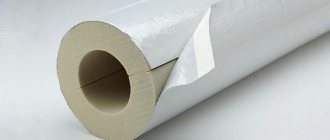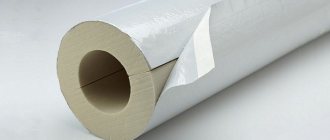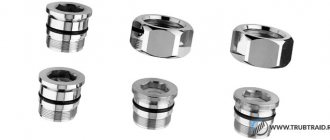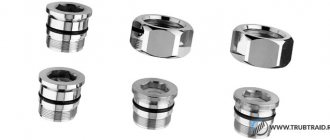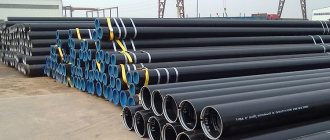The use of energy-saving technologies is designed to reduce heat loss that occurs in utility networks laid on the surface of the earth and pipelines buried in the ground. In order to increase energy efficiency and prevent getting wet and freezing, shell pipe insulation is optimally suited, attractive due to its technical parameters and ease of installation.
Using a “shell” will help you save money by reducing possible heat loss
Read more: a review of methods for thermal insulation of heating pipes.
Purpose and scope of application
The name often used in everyday life - shell for insulating pipes - is not entirely correct, since it does not heat or insulate communications, but only protects coolants from pointless waste of energy. Thermal insulation for shell pipes, depending on the source material, can be a cut cylinder or a set of segments that, when closed, form a casing. They attach easily to most surfaces.
The material is widely used to reduce heat loss:
- networks in cold and hot water supply systems;
- sewer collectors;
- product transportation units in the oil and gas processing industry;
- chemical synthesis engineering communications;
- refrigeration units and cryogenic equipment.
Years later, pipes are as good as new, use protection to ensure long-lasting pipe life.
It is clear that the term “shell” appeared for a reason - a hard and durable material reliably protects the insulated elements, just as a nut shell protects the kernel. In addition to the properties stated in the name itself, thermal insulation of pipelines with shells helps solve a number of other important problems.
This includes maintaining constant temperatures of the media circulating inside the pipelines, protecting pipelines from damage as a result of mechanical influences from the outside, and protecting people from accidental burns when contacting hot surfaces.
In this video we will look at the main differences between shells for thermal insulation made of PPU and PPS:
Insulation using soil
Mainly various thermal insulation materials are used. But, in some cases, land is also used. In this case, the pipe is laid at a depth at which the ground does not freeze. Each region has its own depth of soil freezing.
Therefore, before applying such technology, it is necessary to accurately determine the freezing depth.
The layer of earth that is located above the pipe has a constant temperature. This allows you to protect the external line from freezing. But, unfortunately, it is not always possible to use such a low-cost method.
This is due to the fact that digging a deep trench is a very complex process, especially if this figure exceeds 1 meter.
The problem is not only the laying of the pipeline at great depths, but also the repair of the system. To get to the external sewer, you will need to remove the entire layer of soil. This will require a lot of time and effort.
After digging and repairing the external sewer, you will need to spend a lot of time burying it.
Review of basic materials
The most commonly used polymers in production are polyethylene foam, polystyrene foam, polyurethane foam, and mineral wool. The first type of shell is produced in the form of cylinders with a slot and is well suited for use in field conditions. Their advantages include flexibility, an impressive range of operating temperatures (from -40 to +95°C) and low price. The main disadvantage of polyethylene is its ability to absorb water, which necessitates a complex of waterproofing works. In addition, soft polyethylene slides off the pipe and requires fixation with special tape.
The shell for thermal insulation made of foam plastic (expanded polystyrene) has great rigidity and is produced in the form of two half-cylinders connected by locks, or without them. The advantages of this material include high thermal characteristics, lack of moisture absorption and resistance at temperatures from -50 to +70°C. The main disadvantages: fire hazard, low mechanical strength, requiring protective covers, and the high cost of transporting relatively small volumes of material.
A foam “shell” will help protect pipes from bad weather.
Products made of mineral wool also have a classic appearance for thermal insulation shells: two identical halves connected by a locking system. The main advantages are fire safety, the ability to withstand temperatures from -40 to +74°C and relative low cost.
However, according to a number of criteria, mineral wool does not meet modern requirements for thermal insulation materials, and its scope of application is limited only to plastic pipes.
This is interesting: the characteristics of mineral wool.
The rigid closed-cell structure of polyurethane foam (PPU) practically does not absorb moisture and can withstand temperatures from -180 to +130°C. Gas-filled insulation looks like a cylinder made up of several elements with a locking or lockless connection method. In the first case, the ends of the half-segments are processed according to the tongue-and-groove principle; in the second, the edges have smooth edges. To obtain a 100% seamless connection of the segments to each other, polyurethane glue and additional tie with bandages are used.
Lack of locks does not mean lack of quality
When fixing elements with polymer clamps, wire or metal tapes, the connection will have seams, and this will lead to an increase in heat loss in the line. To insulate shaped assemblies, special bends, elbows, tees and connection angles of 90, 120 and 180° are used. To connect the shells along the length, a special shaped element is used - a coupling.
The free space is filled with polyurethane foam, which ensures complete sealing. Steel pipes require anti-corrosion treatment, since the condensate that accumulates between the metal and the shell has no outlet and activates corrosion processes.
Heating of external sewerage using cable
Electric cable is a modern means that is used to protect external sewers from freezing. This method of thermal insulation is much more effective than the previous one, which concerns the installation of sewage systems at a certain depth.
The electrical cable is laid along the entire external pipeline. The heating cable can also be used at important components of the sewer system. As a result, heating can be carried out at any temperature.
To heat the external sewerage system, a special cable is used. It is fixed with adhesive aluminum tape. First of all, the tape is applied to the pipeline. The cable itself is laid on top of it. After this, the tape is applied over the heating element. This allows you to securely fix the cable on the surface of the pipeline.
Video: insulation of external sewerage with a heating cable
Sewer heating - installation of a heating cable on a pipe.
This method has some disadvantages. First of all, this concerns an increase in energy consumption. If the electrical cable is laid over a fairly long section, this will lead to a colossal increase in the electricity bill.
It is also worth considering that a power outage will cause the cable to stop heating. A generator is used as a backup source. But its installation will entail significant investment.
Advantages, disadvantages and dimensions
The use of polyurethane foam shells for pipe insulation is considered the most promising among existing energy-saving systems. This is due to a number of unique qualities of polyurethane foam. These include:
- low thermal conductivity coefficient and saving up to 40% of resources;
- durability (service life - up to 30 years);
- high anti-corrosion resistance;
- acoustic insulation properties;
- lack of toxicity and environmental safety;
- light weight that does not burden the main structures;
- wide range of manufactured sizes and shapes;
- inertness to mold and other fungi;
- not damaged by rodents and other pests;
- ease of installation;
- quick access to worn areas during repairs;
- possibility of reuse.
Among the disadvantages, the ever-increasing cost of transportation is noted, which makes it economically unfeasible to ship small volumes of shells to remote consumers. The destruction of expanded polystyrene under the influence of ultraviolet rays necessitates the need for protective coatings, and coking at temperatures above 150°C does not allow its use for insulating steam pipelines.
Read more: types of polyurethane foam.
Reflective materials will help provide protection from ultraviolet rays
The shell is widely used indoors, outdoors and underground. Depending on the size of the pipes to be insulated and the need to create multilayer insulation systems, the internal diameters of the elements range from 15 to 1420 mm. Manufacturers often offer a limited set of popular sizes - from 40 to 400 mm. This is due to the demands of consumers purchasing small quantities for the needs of individual construction.
Shells with an internal diameter from 15 to 57 mm are intended for heating and water supply pipes, sizes from 89 to 219 mm are suitable for insulating elevator units and thermal substations, sewer networks use diameters of 108 and 133 mm, technological and main collectors - from 273 mm and more .
Protecting the outer layer of insulation will increase its useful life
The thickness of the product affects its insulating capabilities and increases with the required degree of thermal protection. Its values range from 20 to 80 mm and depend on the dimensions of the cylinder being formed. Thus, an internal shell size of 25 mm corresponds to a maximum thickness of 30 mm, and for a diameter of 1420 mm, the minimum thickness value will be 50 mm, and the maximum value will be 100 mm.
All cylinders have the same length - 1 meter, which is explained by manufacturing features and ease of transportation and installation. The cost of products depends on thickness and diameter. For the needs of insulation of pipelines in private residential buildings, it is lower than for communications of industrial facilities.
Advantages of Foam Pipe Cylinders
During production, the surface area required for insulation is calculated. The thickness of the foam cylinder directly depends on the size of the pipe. Thermal insulating shell for foam pipes in any season of the year and at any temperature. Advantages of creating polystyrene foam thermal protection for pipelines:
- does not allow moisture to pass through;
- prevents the appearance of dampness, mold, and unpleasant putrid odor;
- due to the strong contact of the tenon and grooves, there are no cold bridges;
- reducing costs for troubleshooting and preventive inspections of heating mains;
- significant time savings on insulation operations for many years.
Expanded polystyrene for pipes guarantees reliable protection of communication structures from the appearance of condensation, leading to corrosion. For 50 years or more, the pipeline will effectively perform its functions.
Production methods and types of coatings
For the needs of industrial and civil construction, new heating mains are manufactured so-called. pre-insulated pipes. In this case, the prepared polyurethane foam fills the space between the object being insulated and a special formwork having a larger diameter. The result is a finished product, on the surface of which a protective polyurethane foam layer has already been applied.
Polyurethane foam shells are manufactured in accordance with industry standards and specifications. Depending on the operating parameters determined by the area of application and the pumped media, they are available in two types:
| Brand | Temperature range, °C |
| CT1 | from 100 to 120 |
| CT2 | from 100 to 150 |
Polyurethane foam shells can be produced without coating or have a protective layer: foil, fiberglass, glassine, galvanized steel, which depends on the operational and strength characteristics of the structure. Without additional protection by a casing, shells are used indoors or serve as the bottom layer of insulating “pies.”
Main types of thermal insulation coatings for pipes:
- Foil (foil paper). It is used indoors and to protect internal communications. Not suitable for heating mains with ductless or ducted installation.
- Reinforced foil (armafol). Recommended for economical insulation of networks, both internal and external. Protects against the effects of precipitation under conditions of significant temperature changes.
- Moisture resistant or fiberglass. Suitable for all types of pipelines laid outdoors by air. Provides a durable outer insulating layer and reliably protects against ultraviolet rays. Withstands mechanical loads and is considered optimal in terms of strength properties.
- Glassine (bitumen paper). The roofing material is resistant to ultraviolet radiation, but is inferior to fiberglass in strength.
- Galvanized steel casing. Used for open-laying trunk networks, process lines, gas and oil transportation systems. It serves as both ultraviolet and anti-vandal protection, and in terms of cost it is even preferable to fiberglass.
The variability of insulation will help ensure the required quality and reduce your costs.
Polyurethane foam shells for pipes can withstand more than 1 thousand freezing cycles without changing consumer properties. And if you follow the recommendations for transportation and storage, it allows you to increase the service life of technological communications.
Features of insulation of the external drain system
This process is important and must be approached very carefully. Such work is carried out in order to:
- protect the system from rupture resulting from temperature differences;
- prevent the occurrence of ice jams in the winter season.
Often such problems arise as a result of improper installation. In some cases, insulation can be abandoned. In this case, we are talking about pipes that are laid in the ground at a depth above the freezing level. Here the soil itself will act as insulation.
But, there are cases when you simply cannot do without it. Such situations include:
- laying at a depth of less than 50 cm;
- presence of turns in the pipeline;
- the system slope is less than 5 mm or more than 15 mm;
- northern areas or areas with low temperatures;
- frequent sewer blockages.
In the latter case, the cause of frequent blockages may be the formation of ice plugs under the influence of low temperatures. As for the slope, if it is insufficient, this will lead to the accumulation of a small amount of water in certain sections of the pipeline.
If you don’t know how to insulate an external water pipe, use insulation or heating wire...
Turns lead to a decrease in flow speed. This increases the risk of freezing. All this leads to the formation of ice plugs and rupture of the main line located in the ground.
Video: insulation of external sewerage - necessary or not
Insulation of sewer pipe
If you have determined that insulating the external sewer system is inevitable, then you need to choose the right insulating material. After all, some types used for thermal insulation do not tolerate a humid environment.
As a result, this leads to the installation of an additional protective layer, which will entail some costs. All this must be foreseen at the initial stage of sewer installation.
Stages of installation work
Polyurethane foam shells are practical thermal insulation for steel and polymer pipelines. At the same time, two semi-skilled workers can easily apply a protective coating over a length of up to 150 meters per shift.
Installation of thermal insulation with shells is carried out in several stages:
- Check the isolated area for damage to the pipeline and fittings, eliminate the detected defects and eliminate the causes.
- Carry out anti-corrosion treatment of metal parts. This can be done conveniently using a suitable primer paint.
- If pipes of small or medium diameter are insulated, use a shell of two halves. To fix the elements, control the location of the longitudinal and transverse joints - they should not form one line, but alternate.
- Large-diameter structures are insulated with shells consisting of several parts. Installation is carried out so that there are no gaps between them. When laying more than 1 layer of shell on one section of the pipeline, it is carried out with an offset, which helps to avoid heat loss at the joints.
- The quality of work is improved by gluing the joints of elements with foil or regular tape. On large-sized highways, additional fastening is used with special clamps, steel tape or binding wire.
Specialists involved in the installation and thermal insulation of pipes will help make the “shell” better.
Sewer insulation:
Such ease of installation at high speed of work, environmental friendliness, absence of condensation and ice when installing insulation at any temperature make the advantages of this insulation undeniable. PPU shell, as an important element of energy-saving technologies, serves as a convenient and reliable way to protect pipelines and significantly reduces useless heat loss.
Self-installation of thermal insulation
Work on insulating heating pipes using thermal insulating polystyrene foam shells is carried out as follows:
- The halves of the material are put on the pipe and their displacement relative to each other is ensured - this is required for an overlap measuring 10–20 centimeters.
- The half-cylinders should be secured in advance with tape. If a surface protective layer needs to be applied, it is attached at the very end.
- To ensure that the shell adheres more securely to the pipeline, the joints must be taped.
- When it is necessary to insulate heating pipes at turns in the main, shaped types of shells are used.
In many ways, the choice of materials for insulating heating system elements depends on the operating conditions of the heating main and its structural design. Thermal insulation work is simple and can be done by any home craftsman if desired.
So, when a stove is built and a chimney is installed for it, this does not mean at all that all work on its construction has come to an end.
Thermal insulation shell for external insulation
Shell-type insulation for external sewer pipes is very popular among consumers, and the main advantage is considered to be ease of installation.
Shell-type thermal insulation is made of polystyrene foam and polystyrene foam, and it should be noted that it is successfully used for sound insulation of internal drainage networks, as well as external sewer systems running outdoors and in the ground.
And it is characteristic that external sewerage in the ground does not need to be laid in additional installation trays.
How to bury a sewer pipe deeply to a septic tank?
The shell is very easy to install.
- The two halves, which have an internal volume corresponding to the workpiece to be covered, are only put on it and connected. Apply the shell with a slight overlap.
- For reliability, the overlap points are secured with construction tape.
- Individual shell particles are also secured with tape.
- There are products of different shapes to work with corners and different structures.
- Very rarely, additional coating is used on top for such shells.
IMPORTANT! A very significant advantage of the shell is the possibility of repeated use. The shell elements can be easily dismantled and reinstalled without losing their basic qualities.
Products Leroy Marlene
Insulation for external sewer pipes from Leroy Merlin stands out among the line of similar products. The Leroy Merlin chain of stores offers consumers an assortment of excellent quality at very competitive prices.
Technologies do not stand still and the range is constantly growing. Among the product line of this online store, ready-made insulated pipes should be highlighted.
These are products made of plastic and metal, as well as other materials that can be laid in the ground above the freezing level without fear. When making a purchase from Leroy Merlin, you can be sure that the line will operate smoothly at any temperature.
Their cost will be an order of magnitude higher, and many people insulate simple pipes in the ground with cheaper insulation materials.
All other products from Leroy Merlin are of high quality and affordable prices. The most expensive method is considered to be finishing with basalt glass wool.
All provided building materials can be used for all types of pipe rolling. And each of them meets the requirements for this product:
- Fire resistance.
- Waterproof.
- Long service life.
- Easy to install.
- Low cost.
Insulation of the sewer system in the ground
When choosing thermal insulation, you need to take into account the climatic conditions of the region, the depth of the sewer pipe in the ground, as well as financial capabilities.
Insulation of external sewerage can entail significant investment. This is especially true for pipelines that are long.
The insulation of the sewer pipe is carried out using established technology. First of all, the highway is laid in the ground. To do this, a trench is dug, the width of which depends on the diameter of the pipeline, and the depth is not less than 60 cm.
Ditch dimensions may vary. It all depends on the climatic conditions of the region and the diameter of the pipeline itself.
The width of the trench should be sufficient so that it can be easily laid in the ground. Do not forget about the slope, which is 1 cm per meter of length.
The pipeline is assembled on the surface and then laid in a trench. When joining, it is worth using a sealant. It is applied to the edges of the pipe and rubber seal.
With this you can make a reliable and hermetically sealed joining of pipes. After this, the selected insulating material is put on the pipe.
Insulation is a responsible process. Here you need to make sure that the insulating material fits tightly. It must be securely fixed to the sewer pipe.
To do this, experts recommend using tape that wraps thermal insulation material around the entire perimeter. The adhesive tape acts as a guarantee that the insulation will not slide off the line as a result of soil displacement.
Laying the pipeline in the ground
How to properly lay sewer pipes | Sewer slope
After the insulation is fixed, the pipeline is laid in the trench.
At the same time, do not forget about its slope, which will ensure natural waste flow in the right direction.
The slope is created using a sand cushion, which is placed at the bottom of the trench. It is also advisable to use sand to backfill the external pipeline. But for this you can also take previously dug soil. The main thing is that there are no sharp objects in it that could damage the insulation and the sewer system itself.
Then the system is backfilled and compacted. At this stage, the installation of external sewerage can be considered complete. If all work was carried out correctly, the insulation will serve for a long time.
Table of soil freezing by regions of the Russian Federation
It is important to consider that soil freezing rates are different in each climate zone. You can find out what the standards are for a particular region from specially designed maps. They provide accurate data on the depth of soil freezing.
We offer to download a file where you can find out the level of soil freezing for each region -.
IMPORTANT! This method cannot be used in areas where the freezing depth is more than one meter and where the groundwater level is high.
For example, the level of soil freezing is 1.4 meters, and groundwater is located no deeper than one meter underground. In such conditions, the required level of the cesspool will be constantly filled with water.
But you cannot raise the pipeline close to the surface, otherwise they may freeze. So it turns out that in the current situation it is necessary to look for other, more expensive methods of laying sewer pipes.
Insulating the sewer system at home Is it necessary to insulate sewer pipes in winter?
This method is more suitable for areas with warm climates. In mild winter conditions, the soil does not freeze over a long distance, therefore, trenches for external sewage can not be made very deep.
But, starting from the middle zone areas, deeper trenches will have to be prepared for such highways, and this leads to additional costs for laying communications.
It is also necessary to add here that the pipeline must be laid on a slope, and with each linear meter of the sewerage pipeline, the trenches will have to be deepened. Based on these facts, the conclusion suggests itself is that in cold regions it is more economical to insulate such a system.
Insulation of sewer pipe
ADVICE. In order to maintain a normal temperature in the external sewer line, an inspection well should be installed in the septic tank. It is placed above the lid of the septic tank. This design option creates an additional air “cushion” over the septic tank; it helps maintain positive temperatures at sub-zero temperatures.
As for internal sewerage, it is quite possible to do without insulation, since it operates under the same temperature conditions.
Condensation does not appear on it, like on a cold water supply line. The only place that is insulated on such structures is the outlet of the riser to the roof of the dwelling. In such a place, if there is a sudden change in temperature, the riser may burst.
Insulation of sewerage in a private house Do-it-yourself sewerage in a private house Vacuum valves
Thus, everyone will decide on the need to isolate sewer lines independently after studying all the proposed options. If doubts remain, then it makes sense to get advice from a plumbing specialist who has extensive experience working with these systems.
The specialist will not only give recommendations on the use of this or that type of insulation for external sewerage, but will also help with installation work. The money spent in this case will be the key to trouble-free operation of the sewer pipelines, and in winter there will be no emergency situation requiring complex repairs.
Insulation of external sewer pipes can be done using different methods. When choosing, priority is given to certain climatic conditions, pipe laying features, the depth of the main line, cost, and so on.
If everything is done correctly, then such a nuisance as the formation of ice plugs in the system is minimized. This means that the system will not fail even in the coldest period.
